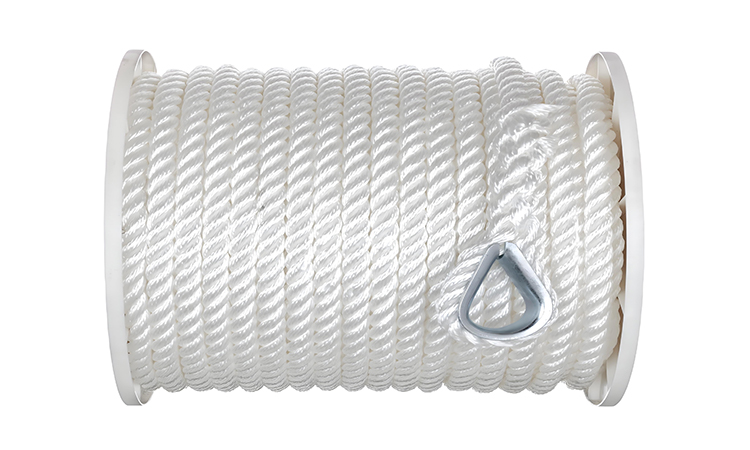When we purchase ropes for marine use, pre-spliced lines with eyes may be more convenient, but typically with higher costs and limited lengths. So, if you can splice an eye loop by yourself, it will be more economical and suitable.
Marine Three Strand Rope Step-by-Step Splicing Instructions

When splicing an eye into a three cord rope, you need to ensure that every step will be absolutely accurate so that the outcome will be safe and reliable.
Step 1: Prepare the Rope
First, we need to tape two ends of the three strand rope, preventing its unraveling and ensuring the workplace is clean and tidy. During the splicing process, we should fix each single chain tightly to keep structural integrity.
Step 2: Unlay the Strands
In order to set up a foundation for slicing, we need to unwind one strand for eight revolutions around the other two, preparing for the later weaving. Then untwist other remaining strands carefully, as the premise of following intricate knitting.
Step 3: Initiate the Splice
With the groundwork set, initiate the splice by crafting a loop at the desired eye size from the taped point. As you begin to form the eye loop, tuck the center strand under a standing strand, gradually closing the loop with precision and finesse.
Step 4: Continue Tucking
As splicing the strands, we need to continue to refine it. To do this, we should tuck the left-hand strand under the strand above the previously tucked center strand. Every time we tuck, we must be careful so that the integration of the strands will be seamless.
Step 5: Third Tuck Precision
To maintain the structural integrity of the splice, ensure that the right strand goes under the strand below the previously tucked left strand. Consistency in tucking direction (right to left) and alignment is paramount, guaranteeing a strong and resilient eye splice.
Step 6: Finalize the Splice
As the splice nears completion, alternate tucks, weaving under, over, and under adjacent strands to reinforce the integrity of the eye splice. Repeat the tucking process for each strand, completing a total of six tucks while meticulously maintaining sequence and strand alignment. Once the splice is secure, smooth it by rolling it underfoot and rigorously test its strength before delicately trimming any excess strands, ensuring a clean and robust finish.
Ideal Marine Rope Types for Splicing

The splicing technology, especially those used for creating eye splicing in marine ropes, is suitable for triple braid ropes, also named laid ropes. These ropes are typically made of special materials like nylon, polyester, or polypropylene so that they possess higher strength, durability, and flexibility. That’s why they are often extensively used in various marine applications.
Three Strand Nylon Rope
In the realm of marine rigging, the three strand nylon rope stands as a testament to versatility and resilience. Renowned for its elasticity, formidable strength, and remarkable resistance to abrasion, three strand nylon ropes embody a trifecta of durability in maritime settings. Their optimal performance shines in situations requiring shock absorption and adaptability, particularly when securing dock lines and anchor lines. Nylon’s robust characteristics make it a stalwart choice in the unforgiving waters of marine environments where durability is non-negotiable.
Polyester Three Strand Rope
With a shield of exceptional UV resistance, minimal stretch, and unparalleled strength, polyester three strand braid ropes epitomize durability in rigging applications. Tailored for scenarios demanding minimal elongation and robust tensile strength, like the hoisting of halyards and rigging lines, polyester ropes carve a path of steadfastness in the face of marine challenges. Their resilience to prolonged sunlight exposure positions them as the go-to choice for rigging tasks that hinge on longevity and unwavering reliability in the ever-changing elements of the sea.
Polypropylene Three Strand Rope
In marine applications, the polypropylene three strand rope emerges as a symbol of versatility and resilience. Known for their lightweight build, buoyancy on water, and resistance to diverse chemicals, these ropes exemplify adaptability in challenging environments. Ideal for scenarios where buoyancy and chemical durability are essential, like in towlines and marine safety lines, polypropylene ropes showcase their ability to float and withstand exposure to harsh elements.
Buy Three Strand Rope at Zava Marine

Navigate the high seas confidently with Zava Marine’s premium selection of three strand ropes. Drawing from our extensive expertise in manufacturing ship ropes, we offer a diverse range of high-quality ropes tailored specifically for various marine applications.
At Zava Marine, each three cord rope is meticulously crafted to excel in the demanding marine environment, characterized by superior strength, durability, and resilience. Whether you require ropes for securing dock lines, anchor lines, halyards, or rigging lines, our collection is designed to meet your specific needs with precision.
According to our deep understanding of the marine environment, our ropes possess outstanding performances, buoyancy, and chemical resistance, so it is believed that ropes provided by Zava Marine will not only comply with standards but also more than our expectations. They guarantee the security, dependability, and lifespan of all your maritime activities. Moreover, the unrivaled quality of a triple braid rope from Zava Marine is tailor-made for your needs, and that will improve your marine operations to a new high.






